

Springpole Project
I recently saw an investor presentation from First Mining Gold about their Springpole Project. The situation is that their open pit is located within a lake and will require the construction of a couple of small cofferdams to isolate the pit area from the lake. The concept is shown in this image.
Over the last couple of years I have been involved in a few early-stage studies for mining projects in which nearby bodies of water play a role in the design. In Canada’s north there are thousands of lakes and rivers, so its not surprising to find mines next to them.
That got me thinking about how many other mines are in the same situation, i.e. projects that may be located very close to, or within, a lake, river, or ocean. Hence I have compiled a short list of a few such mines.
I have been directly involved with some of those in the list, while others are only known to me with limited detail. Some mines I had never heard of before, but their names were provided to me by some Twitter colleagues.
My observation is that building a mine within, or adjacent to, a body of water is nothing new and this has been done multiple times successfully.
Some of these projects may refer to the dams as “dikes”, “cofferdams”, “sea walls” but I assume they are all providing roughly the same function of holding back water for the life of the project. They are not viewed as permanent dams.
This is Part 1 of a two-part blog post. Part 1 provides some examples of projects where water bodies were involved in the design. Part 2 provides a discussion on specific geotechnical and hydrogeological issues that would normally have to be examined with such projects.
Some Lake Mining Examples
The following are some examples of operating mines involving lakes. I have captured a few Google Earth images, unfortunately some have only low resolution vintage satellite imagery.
Diavik Diamond Mines, NWT
This is a project I was working on with in 1997 to 2000 while it was still at the design and permitting stage. My role focused on pit hydrogeology and geotechnical as well as mine planning.
The project would require the construction of three dikes in sequence to mine four lakebed kimberlite pipes.
The three dikes were named after the associated kimberlite pipe being mined inside it; A154, A418, and A21.
The first dikes were built in 2002 and the last dike (A21) was completed in 2018.
The total dike length for the three dikes is about 6.2 km.
For those interested in learning a bit more about Diavik, I have posted an earlier article about the open pit hydrogeology there, linked to at " Hydrogeology At Diavik – Its Complicated".
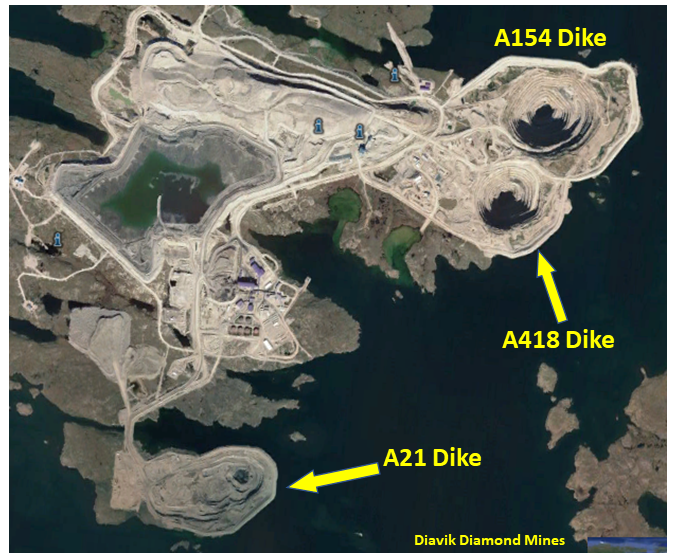
Gahcho Kue, NWT
This is a DeBeers diamond project was built in 2016 and required the construction of several small dikes to allow access for open pit mining. The photos show the pre-mining situation and the site as it is today. One can see the role the lake would play in the site layout and the need for multiple small dikes.

Meadowbank, NWT
This is an Agnico-Eagle gold mining operation built in 2010 that required a cofferdam to be built around one of their open pits (see image).
The total dike length is about 2000 metres. I don't know much more about it than that unfortunately.

Cowal Gold Mine, Australia
Yes, a lake in Australia ! This is a former Barrick operation, now owned by Evolution Mining, and is another example where the mine is located within the shoreline of a lake (Lake Cowal). I don't know much about this, the name was kindly provided to me by a colleague.
The total dike length appears to be about 3000 metres.
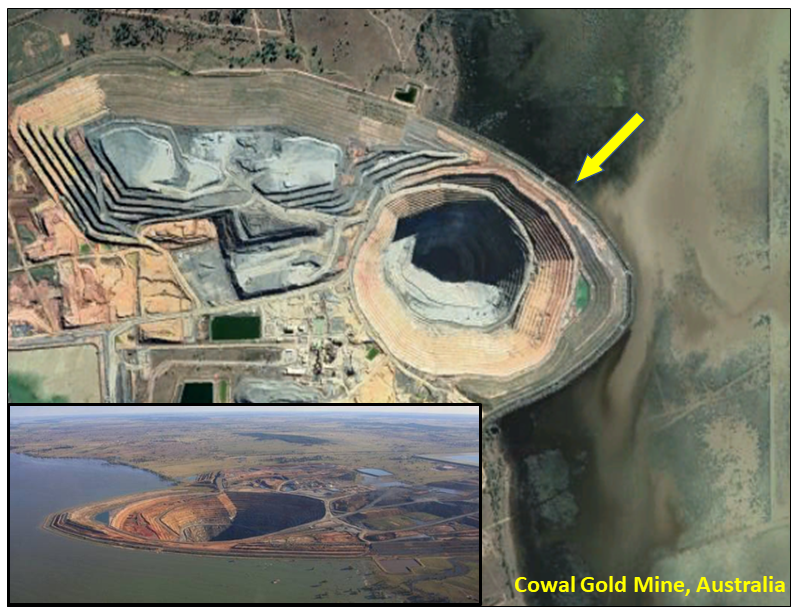
Rabbit Lake Sask
The historical Rabbit Lake uranium mining operation required the construction of cofferdams around a few of their open pits. They are now reclaimed and flooded.
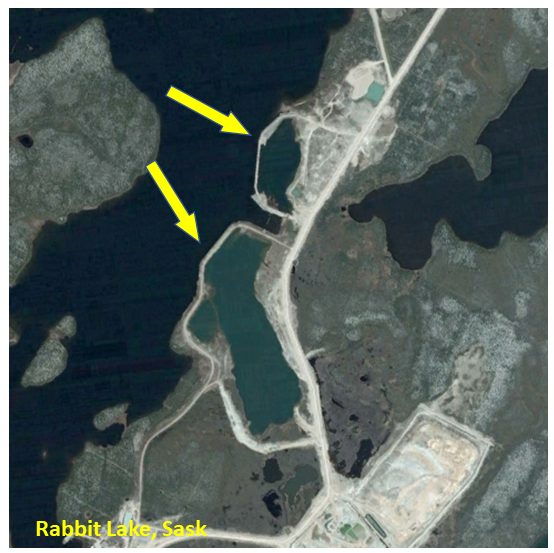
St Ives Gold Mine, Australia
This is a unique situation in that several pits are located within an ephemeral (intermittent) salt lake and dikes were required to prevent pit flooding during wet season.
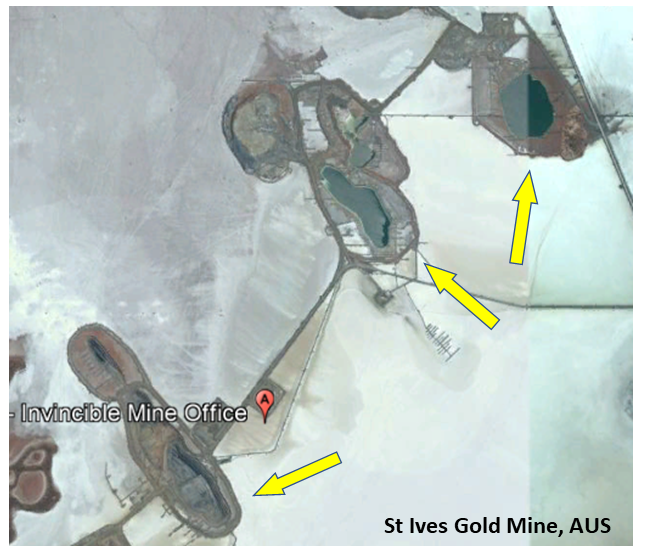
Some River Mining Examples
The following are some examples of operating mines involving rivers. Rivers provide a somewhat different design challenge since they have flowing water, who's volume and velocity may change seasonally. Constrictions in the river created by the dike itself may increase the flow velocity and erosion potential.
Gorevsky Mine, Siberia
This lead-zinc operation has an orebody that extends into the Angara River.
This mine has built a fairly large cofferdam into the river, and is currently mining a large pit within it. The total cofferdam length appears to be about 4000 metres.
It would be interesting to see how close the pit will get to the cofferdam. We'll check back in a few years.
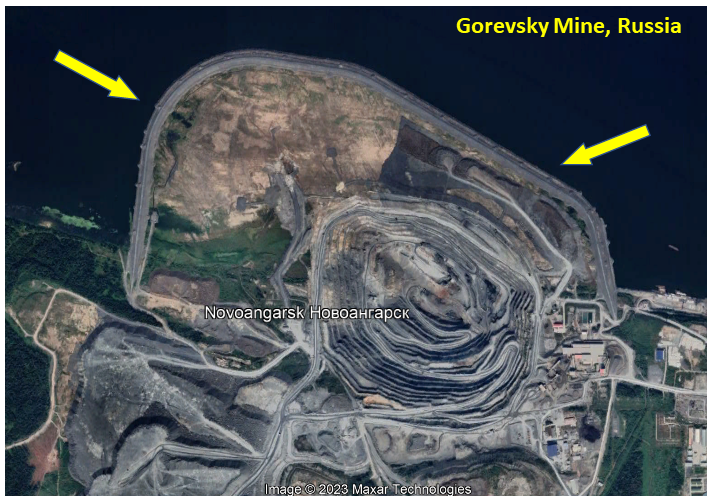
BHP Suriname Bauxite Mine
This is a project I was involved with several years ago. The bauxite deposit extends beneath the Suriname River and the goal was to mine as much ore as possible.
Given the flow rates in the river, especially during the wet season, it would be difficult to maintain a cofferdam out into the river.
The shoreline overburden consisted of sands and soft clays, so the decision as made to construct a sheet piling wall along the river bank to protect the pit from river erosion. This was mined out successfully and eventually reclaimed.

McArthur River, Australia
In situations where the river (creek) is small enough and the topography allows, one can divert the entire river around the mine.
There are several examples of this in Canada and elsewhere. Here’s the McArthur River lead-zinc mine in Australia, where they channeled their small river around the open pit.
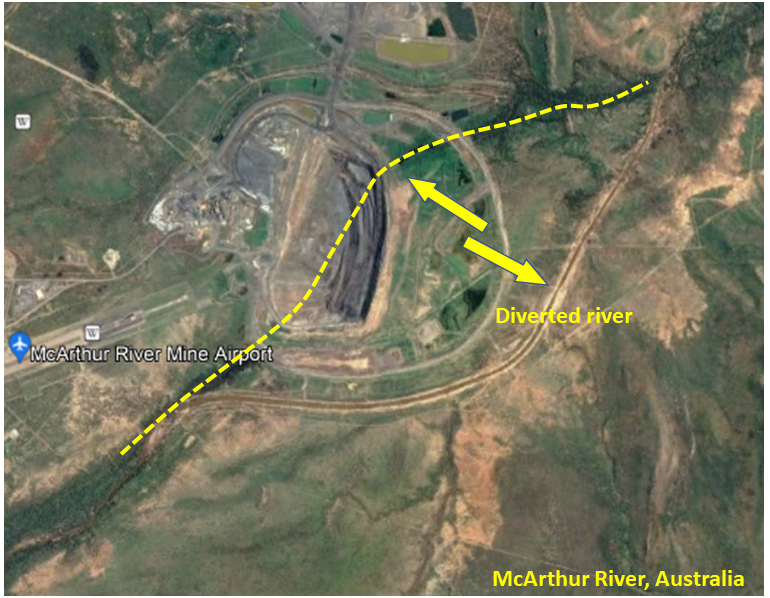
An Ocean Example
There are some examples of mining near the ocean. These operations may need to deal with large storm water level surges and large tidal fluctuations. The Island Copper Mine on northern Vancouver Island is an example where they mined close to the shoreline but not actually into the ocean (as far as I am aware).
Cockatoo Island Mine, Australia
This interesting iron ore mine has an ore zone that dips 60 degrees, is 35 metres wide, with a strike length of more than one kilometre.
A sea wall was constructed to prevent any tidal water from entering the open pit that was to be mined, with reportedly high tidal fluctuations there.
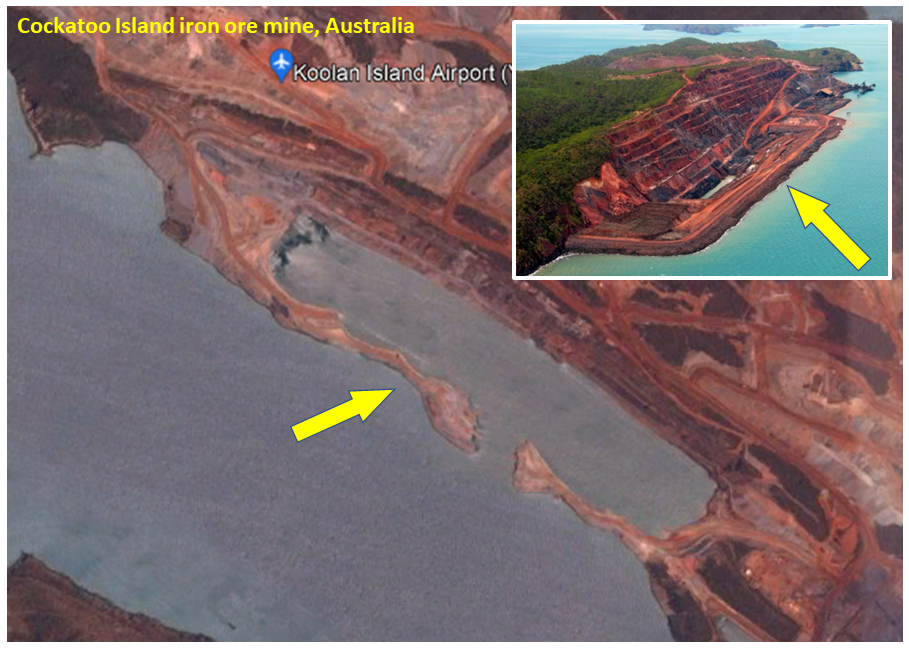
Conclusion
As one can see, the idea of mining into a body of water is nothing new. Its not a preferred situation, but it can be done economically and safely. The technical challenges are straightforward, and engineers have dealt with them before. However there also are instances where the design could not economically address the water issue, and thus played a role in the mine not getting built.
If you know of other mines not listed above that have successfully dealt with a water body, please let me know and I can update this blog post.
This concludes Part 1. Part 2 can be read at this link " Mining Under Lakes – Part 2: Design Issues" discusses some of the concerns that engineers need to consider when building a mine in these situations.
Pantai Remis tin mine
Finally, the worst-case scenario is shown in this grainy video of a tin mine (Pantai Remis Mine) pit slope failure. It seems they mined too close to the ocean. Watch to the end, its hard to believe. Its looks like something out of a Hollywood disaster movie.



 NPV One is targeting to replace the typical Excel based cashflow model with an online cloud model. It reminds me of personal income tax software, where one simply inputs the income and expense information, and then the software takes over doing all the calculations and outputting the result.
NPV One is targeting to replace the typical Excel based cashflow model with an online cloud model. It reminds me of personal income tax software, where one simply inputs the income and expense information, and then the software takes over doing all the calculations and outputting the result. Pros
Pros Like anything, nothing is perfect and NPV may have a few issues for me.
Like anything, nothing is perfect and NPV may have a few issues for me. The NPV One software is an option for those wishing to standardize or simplify their financial modelling.
The NPV One software is an option for those wishing to standardize or simplify their financial modelling.
 We likely have all heard the statement that increasing pit wall angles will result in significant cost savings to the mining operation.
We likely have all heard the statement that increasing pit wall angles will result in significant cost savings to the mining operation. The results of applying the increased inter-ramp angle to each of the four pits is shown in the Bar Chart. Note that the waste reduction is not necessarily the same for each pit. It depends on the specific topography around each pit.
The results of applying the increased inter-ramp angle to each of the four pits is shown in the Bar Chart. Note that the waste reduction is not necessarily the same for each pit. It depends on the specific topography around each pit. In general one can typically see four positive outcomes from adopting steeper pit walls. They are as follows:
In general one can typically see four positive outcomes from adopting steeper pit walls. They are as follows: 4. Pit Crest Location: The steeper wall angles result in a shift in the final pit crest location. The Image shows the impact that the 5 degree steepening had on the crest location for one of the pits in this scenario.
4. Pit Crest Location: The steeper wall angles result in a shift in the final pit crest location. The Image shows the impact that the 5 degree steepening had on the crest location for one of the pits in this scenario. It is relatively easy to justify spending additional time and money on proper geotechnical investigations and geotechnical monitoring given the potential slope steepening benefits.
It is relatively easy to justify spending additional time and money on proper geotechnical investigations and geotechnical monitoring given the potential slope steepening benefits.

 I remember in the late fall of that year, the company had a chance to bid on a larger project in Gros Morne National Park, Newfoundland. So our President, Frank Nolan (he was a brother to Fred Nolan, the infamous land-owner at Oak Island, by the way), decided he wanted to see the site and he chartered a Bell 106 helicopter to fly us there from Deer Lake. It was December (they say “December month” in that province) and when we got close to the Park, we ran into a sudden snow squall.
I remember in the late fall of that year, the company had a chance to bid on a larger project in Gros Morne National Park, Newfoundland. So our President, Frank Nolan (he was a brother to Fred Nolan, the infamous land-owner at Oak Island, by the way), decided he wanted to see the site and he chartered a Bell 106 helicopter to fly us there from Deer Lake. It was December (they say “December month” in that province) and when we got close to the Park, we ran into a sudden snow squall. The QMM field office In Port Dauphin, Madagascar was located near the edge of town, and I typically walked from my lodging to the office each morning when I was there, about the time when school started for the children. Typically I passed dozens and dozens of tiny bamboo huts with corrugated metal roofs, and dirt floors each about 2 meters square.
The QMM field office In Port Dauphin, Madagascar was located near the edge of town, and I typically walked from my lodging to the office each morning when I was there, about the time when school started for the children. Typically I passed dozens and dozens of tiny bamboo huts with corrugated metal roofs, and dirt floors each about 2 meters square.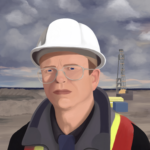 It is one thing to briefly visit a remote project as part of a review team. It is another thing to be there as part of a design team trying to solve a problem and engineer a solution. I know of many engineers and geologists that would have similar work life experiences as part of their careers. However John has taken the initiative to write it all down.
It is one thing to briefly visit a remote project as part of a review team. It is another thing to be there as part of a design team trying to solve a problem and engineer a solution. I know of many engineers and geologists that would have similar work life experiences as part of their careers. However John has taken the initiative to write it all down.
 Overburden is a generalized termed used to describe unconsolidated material encountered at a mine. It can consist of gravels, sands, silts, and clays and combinations of each. Usually overburden is not given much focus in many mining studies. Very often, the overburden as a unit, is not adequately characterized.
Overburden is a generalized termed used to describe unconsolidated material encountered at a mine. It can consist of gravels, sands, silts, and clays and combinations of each. Usually overburden is not given much focus in many mining studies. Very often, the overburden as a unit, is not adequately characterized. These are the clays most people are familiar with, i.e. a sedimentary deposit of very fine particles that have settled in a calm body of water. Normally consolidated clays are generally not a problem, other than having a high moisture content. As such, they can be very sticky in loader buckets, truck boxes, and when feeding crushers.
These are the clays most people are familiar with, i.e. a sedimentary deposit of very fine particles that have settled in a calm body of water. Normally consolidated clays are generally not a problem, other than having a high moisture content. As such, they can be very sticky in loader buckets, truck boxes, and when feeding crushers.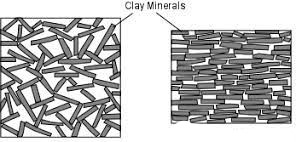 Clays in general consist of very fine plate like particles, as shown in this sketch. In over-consolidated clays, these particles have been flattened and tightly compressed as in the right image. The result is that the clay may be dense, have a good cross bedding shear strength, but very low shear strength along the plates. This characteristic is analogous to the lubricating properties of graphite, which is facilitated by sliding along graphite plates.
Clays in general consist of very fine plate like particles, as shown in this sketch. In over-consolidated clays, these particles have been flattened and tightly compressed as in the right image. The result is that the clay may be dense, have a good cross bedding shear strength, but very low shear strength along the plates. This characteristic is analogous to the lubricating properties of graphite, which is facilitated by sliding along graphite plates.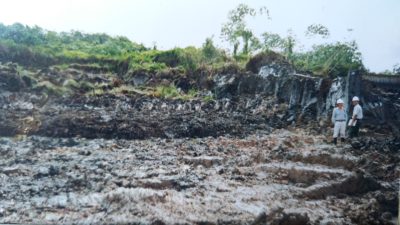 My experience with sensitive clays was at the former BHP bauxite mining operations along the northern coast of Suriname. There were Demerara clay channels up to 20m thick over top of many of their open pits. The bucketwheel excavators used for waste stripping would trigger the quick clay slope failures, sometimes resulting in the crawler tracks being buried and unfortunately also causing some worker fatalities.
My experience with sensitive clays was at the former BHP bauxite mining operations along the northern coast of Suriname. There were Demerara clay channels up to 20m thick over top of many of their open pits. The bucketwheel excavators used for waste stripping would trigger the quick clay slope failures, sometimes resulting in the crawler tracks being buried and unfortunately also causing some worker fatalities. I recall walking up towards a bucketwheel digging face as the machine quietly churned away. About 70 metres from the machine, we would see cracks quietly opening all around us as the ground mass was starting to initiate its flow towards the machine. Most times the bucketwheel could just sit there and dig. Instead of the machine having to advance toward the face, the face would advance towards the machine.
I recall walking up towards a bucketwheel digging face as the machine quietly churned away. About 70 metres from the machine, we would see cracks quietly opening all around us as the ground mass was starting to initiate its flow towards the machine. Most times the bucketwheel could just sit there and dig. Instead of the machine having to advance toward the face, the face would advance towards the machine. The formation of the diamond deposits in northern Canada often involved the explosive eruption of kimberlite pipes under bodies of water. The lakebed muds and expelled kimberlite by the eruption would collapse back into the crater, resulting in a mix of mud and kimberlite (yellow zones in the image). This muddy kimberlite could be soft, weak, and difficult to mine with underground methods.
The formation of the diamond deposits in northern Canada often involved the explosive eruption of kimberlite pipes under bodies of water. The lakebed muds and expelled kimberlite by the eruption would collapse back into the crater, resulting in a mix of mud and kimberlite (yellow zones in the image). This muddy kimberlite could be soft, weak, and difficult to mine with underground methods. At many tropical mining operations (west African gold projects for example) the upper bedrock has undergone weathering, resulting in the fresh rock being decomposed into saprolite. This clay-rich material can exceed 50 metres in thickness, can be fairly soft and diggable without blasting. This is an obvious mining cost benefit.
At many tropical mining operations (west African gold projects for example) the upper bedrock has undergone weathering, resulting in the fresh rock being decomposed into saprolite. This clay-rich material can exceed 50 metres in thickness, can be fairly soft and diggable without blasting. This is an obvious mining cost benefit. Compacted clay fill can also be used as a pond liner material for water retention ponds.
Compacted clay fill can also be used as a pond liner material for water retention ponds.
 Mining has been a part of my life for as long as I can remember. Being born in Sudbury, many of my family members have been, or are currently involved, in mining through a variety of occupations, including my father who I idolized. However, I never knew my true interest in the industry until my 11th-grade technology class. I had a teacher who was passionate about the mining industry, and he created a project that involved developing a very basic mine design.
Mining has been a part of my life for as long as I can remember. Being born in Sudbury, many of my family members have been, or are currently involved, in mining through a variety of occupations, including my father who I idolized. However, I never knew my true interest in the industry until my 11th-grade technology class. I had a teacher who was passionate about the mining industry, and he created a project that involved developing a very basic mine design. Before my first year of university, I had a summer job tramming at Macassa Mine in Kirkland Lake Ontario, which has been in production since 1933. My mentality was to get the boots on the ground and get the job done, whatever it took (with proper safety precautions of course). Using rail systems, dumping ore cars manually, jackleg drilling, etc. gave me the perspective that mining was archaic, mining was rough, and mining was only about the ounces.
Before my first year of university, I had a summer job tramming at Macassa Mine in Kirkland Lake Ontario, which has been in production since 1933. My mentality was to get the boots on the ground and get the job done, whatever it took (with proper safety precautions of course). Using rail systems, dumping ore cars manually, jackleg drilling, etc. gave me the perspective that mining was archaic, mining was rough, and mining was only about the ounces.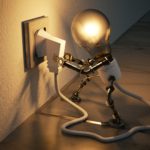 To change the negative view around mining, I believe the main focal point should be electric equipment and the ability for remote operation/work. With all this newly developed technology at our fingertips, I know that future operations will be safer and more sustainable, which should be better portrayed.
To change the negative view around mining, I believe the main focal point should be electric equipment and the ability for remote operation/work. With all this newly developed technology at our fingertips, I know that future operations will be safer and more sustainable, which should be better portrayed. Even creating a mining simulation video game where you can run through a story of being a manager, excavator/scoop operator, truck driver, etc. would get the thought of mining brought into the coming generations at a younger age. This would increase the talent pool from the more typical operator because more and more youth are getting skilled at remote operation through video games due to their increased screen time.
Even creating a mining simulation video game where you can run through a story of being a manager, excavator/scoop operator, truck driver, etc. would get the thought of mining brought into the coming generations at a younger age. This would increase the talent pool from the more typical operator because more and more youth are getting skilled at remote operation through video games due to their increased screen time. People get comfortable and people are afraid to leave home, so selling a career that allows for boundless flexibility in job tasks and constant stimulation while living wherever you desire could allow a shrinkage in the current technical gap.
People get comfortable and people are afraid to leave home, so selling a career that allows for boundless flexibility in job tasks and constant stimulation while living wherever you desire could allow a shrinkage in the current technical gap. So do I think the mining industry is archaic…. not anymore.
So do I think the mining industry is archaic…. not anymore. Firstly, I would like to thank this engineer for taking time to write out his well formed thoughts, and for allowing me to share them.
Firstly, I would like to thank this engineer for taking time to write out his well formed thoughts, and for allowing me to share them.
 In today’s world, it is an onerous task to permit, finance, build, and operate a new mine. This is a significant achievement.
In today’s world, it is an onerous task to permit, finance, build, and operate a new mine. This is a significant achievement. I would suggest that the three reporting categories be used instead of two, described as follows:
I would suggest that the three reporting categories be used instead of two, described as follows:
 The DRX Drill Hole and Reporting algorithm developed by
The DRX Drill Hole and Reporting algorithm developed by 





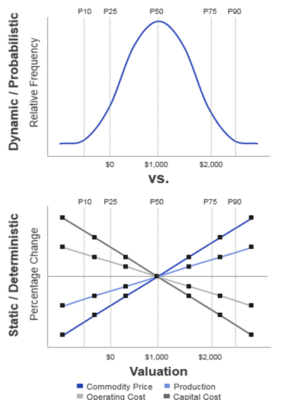

 Often in 43-101 technical reports, when it comes to pit optimization, one is presented with the basic “NPV vs Revenue Factor (RF)” curve. That’s it.
Often in 43-101 technical reports, when it comes to pit optimization, one is presented with the basic “NPV vs Revenue Factor (RF)” curve. That’s it.
 Pit optimization is a approximation process, as I outlined in a prior post titled “
Pit optimization is a approximation process, as I outlined in a prior post titled “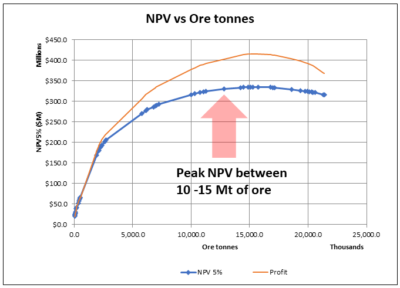







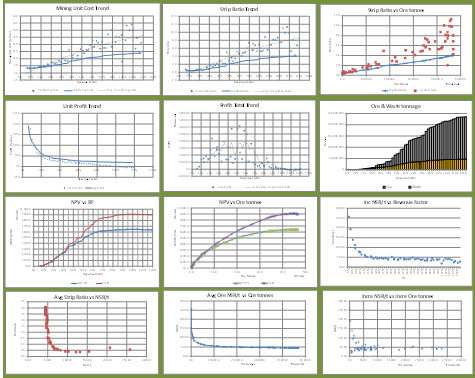 It’s always a good idea to drill down deeper into the optimization output data, even if you don’t intend to present that analysis in a final report. It will help develop an understanding of the nature of the orebody.
It’s always a good idea to drill down deeper into the optimization output data, even if you don’t intend to present that analysis in a final report. It will help develop an understanding of the nature of the orebody.